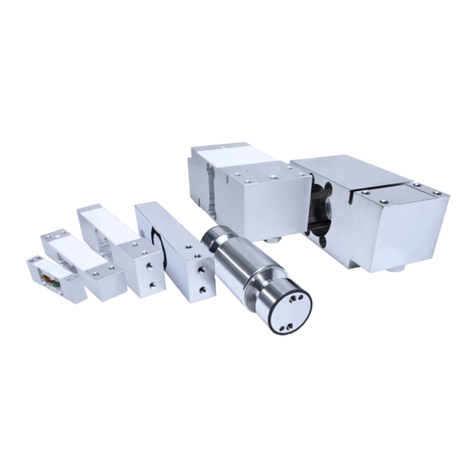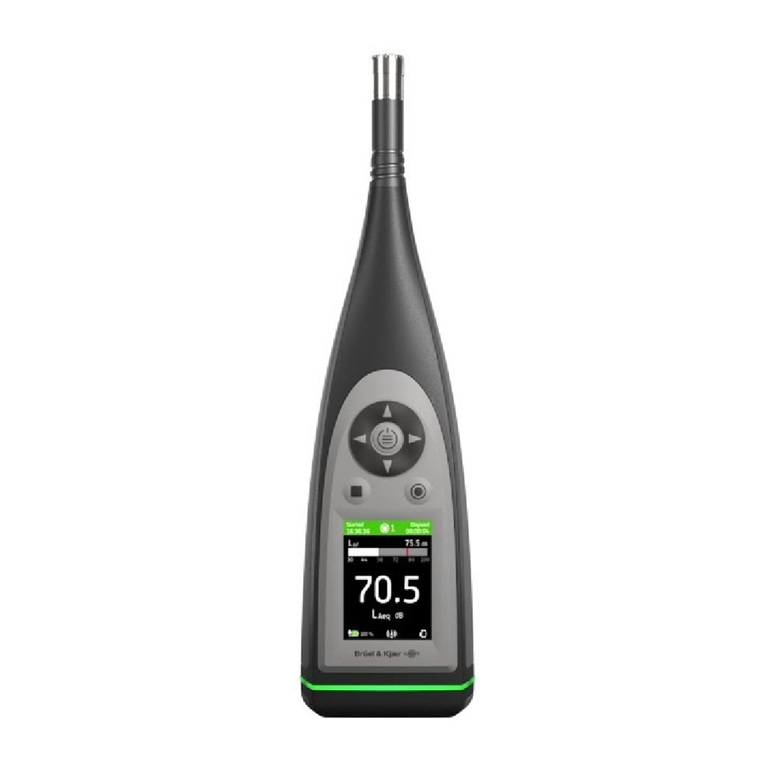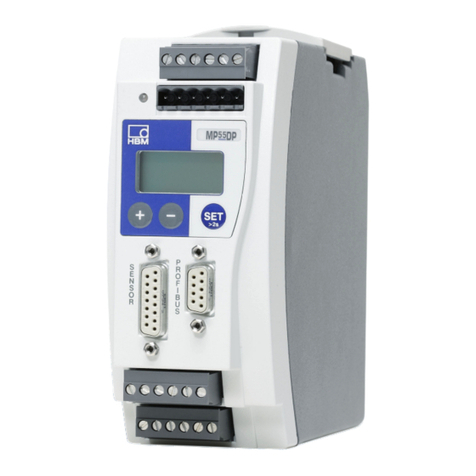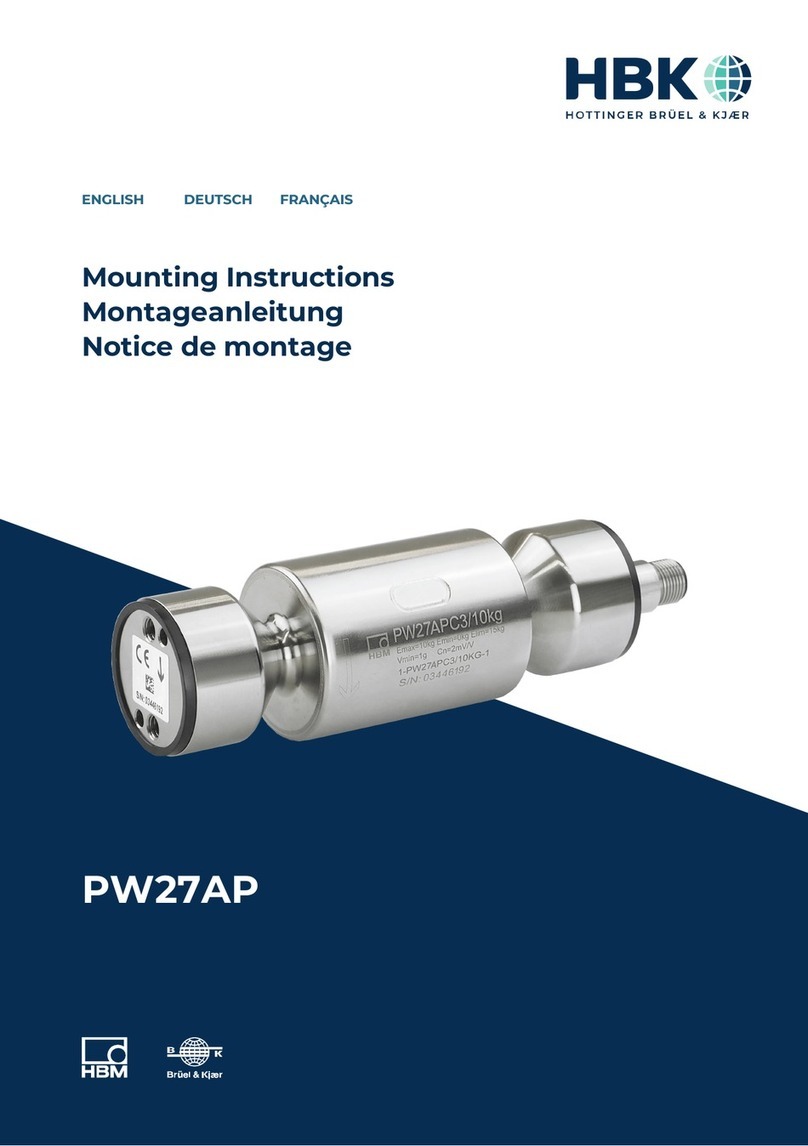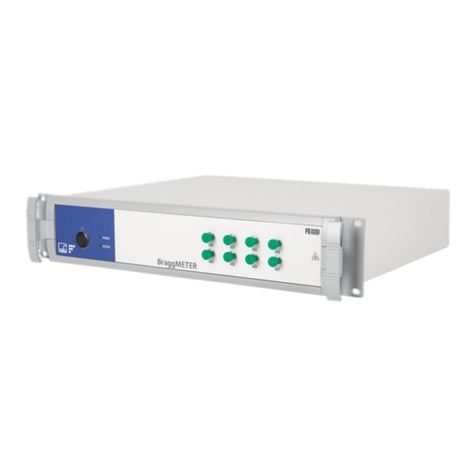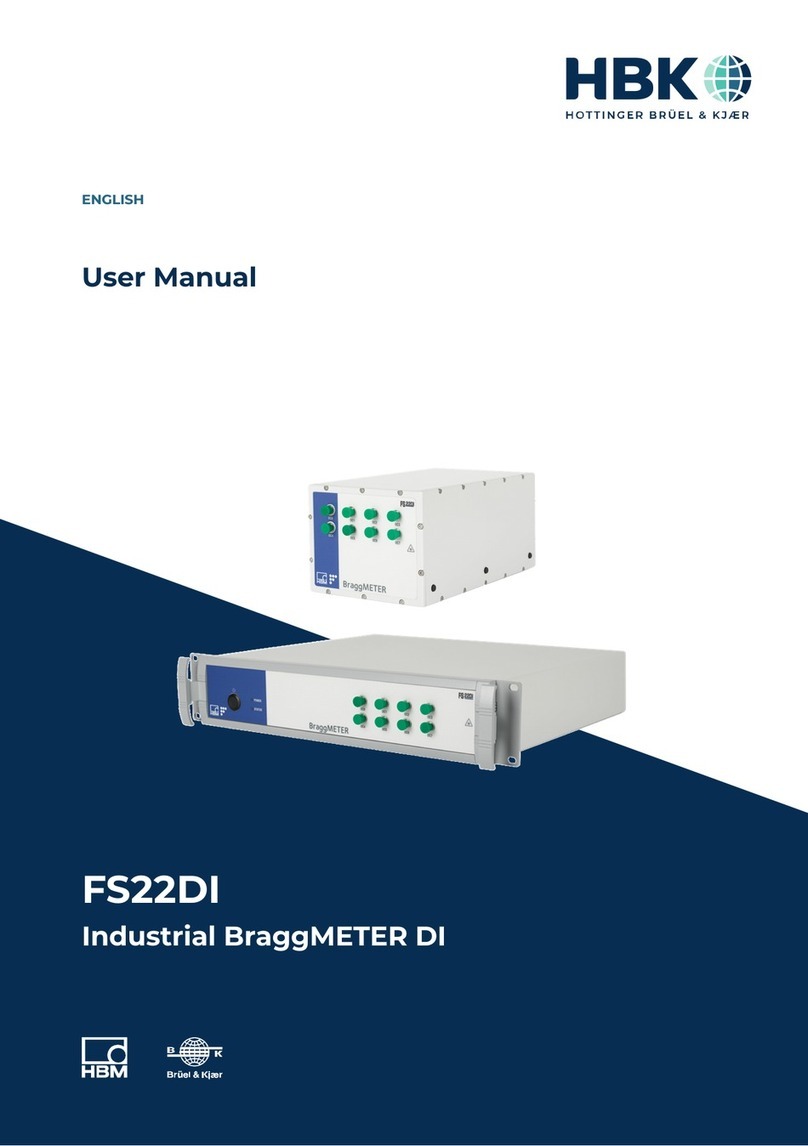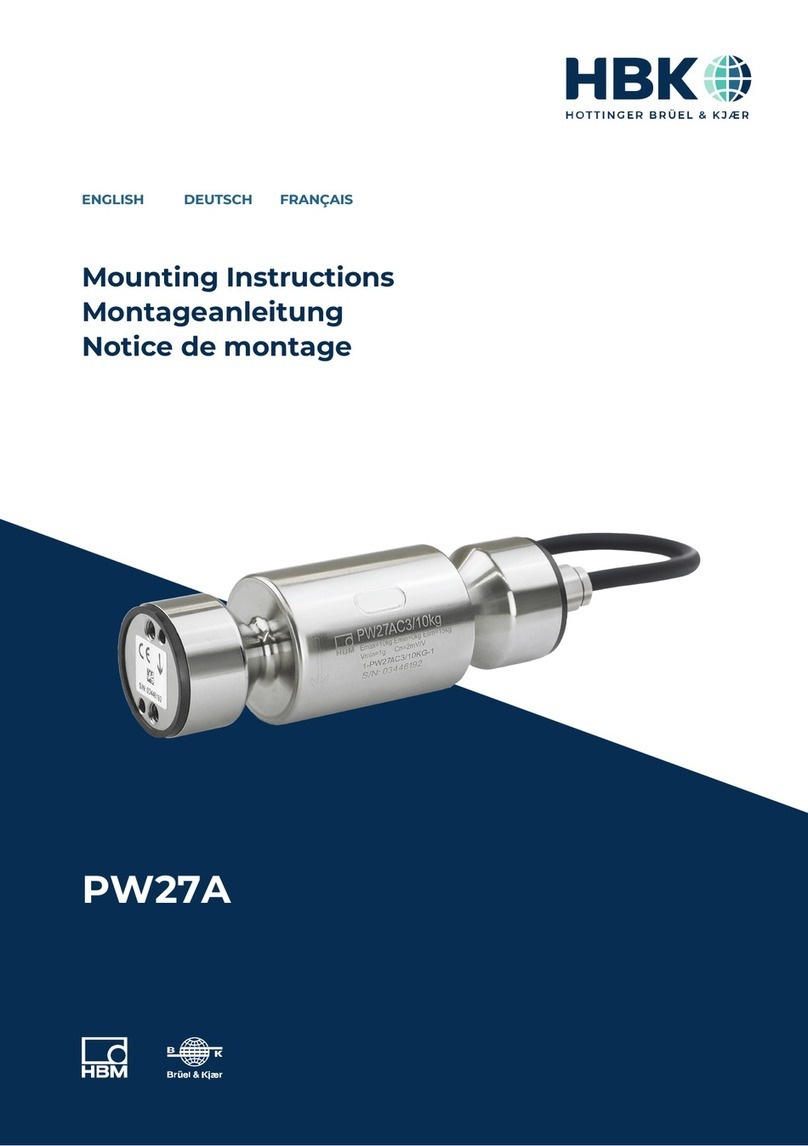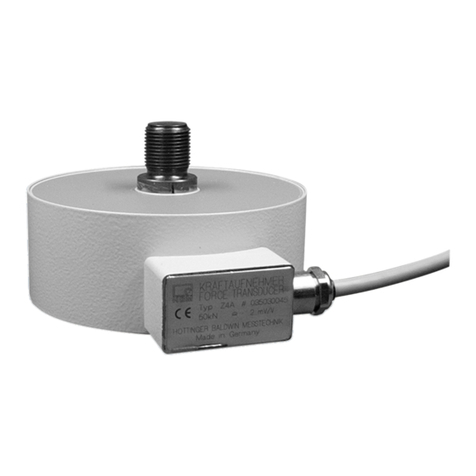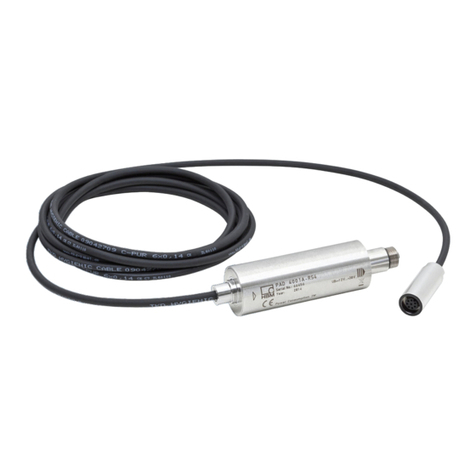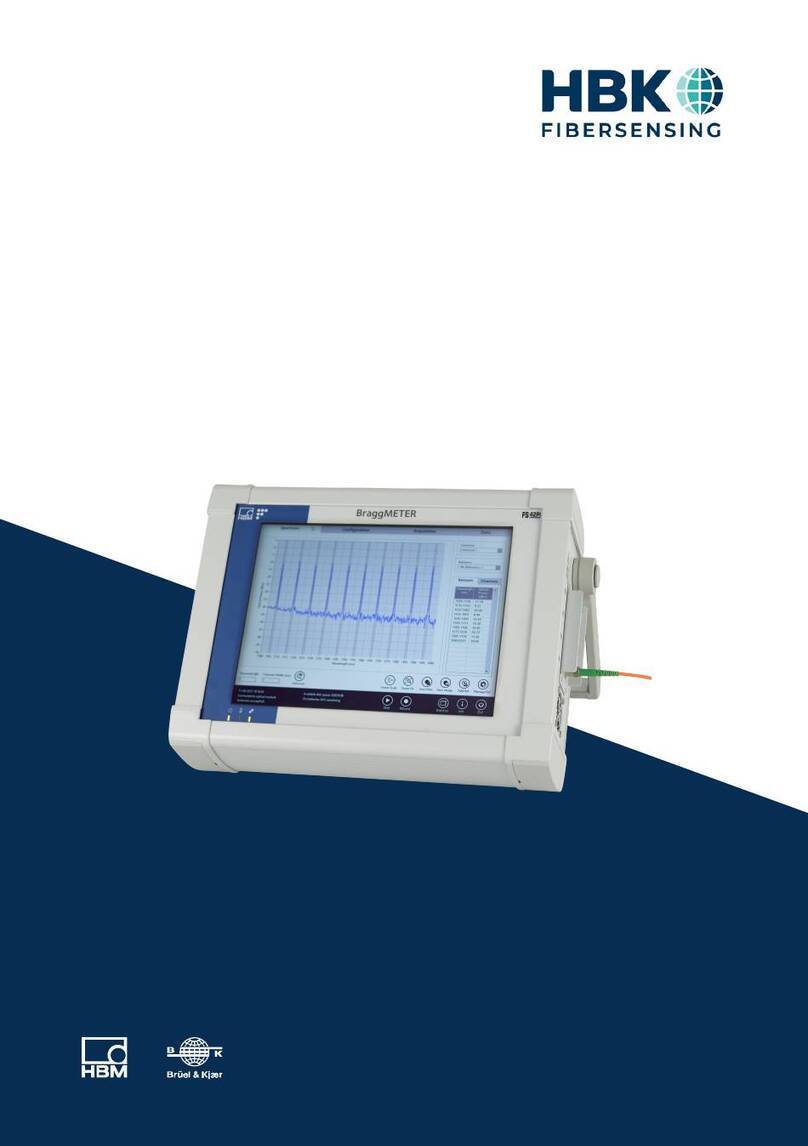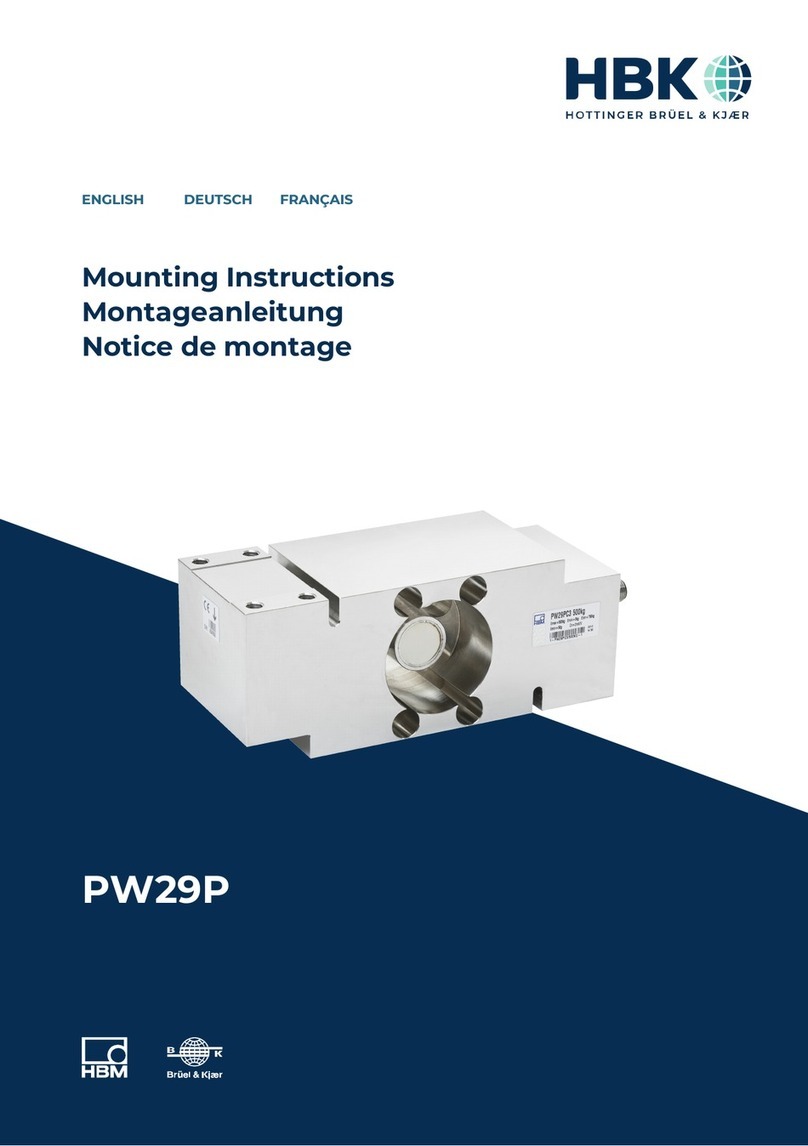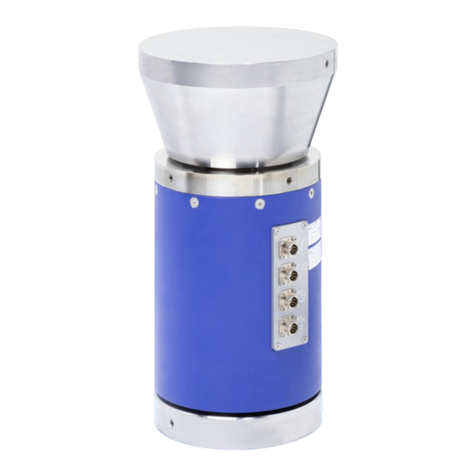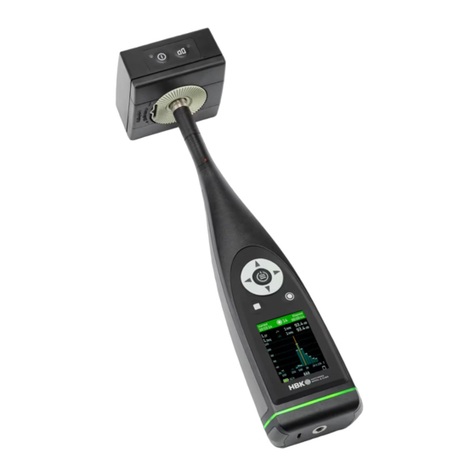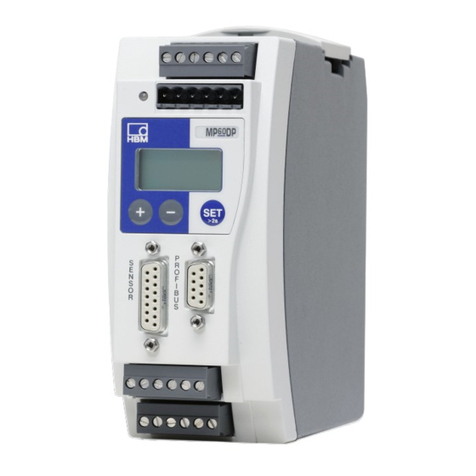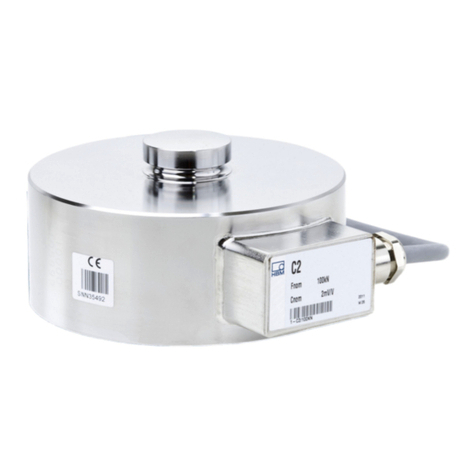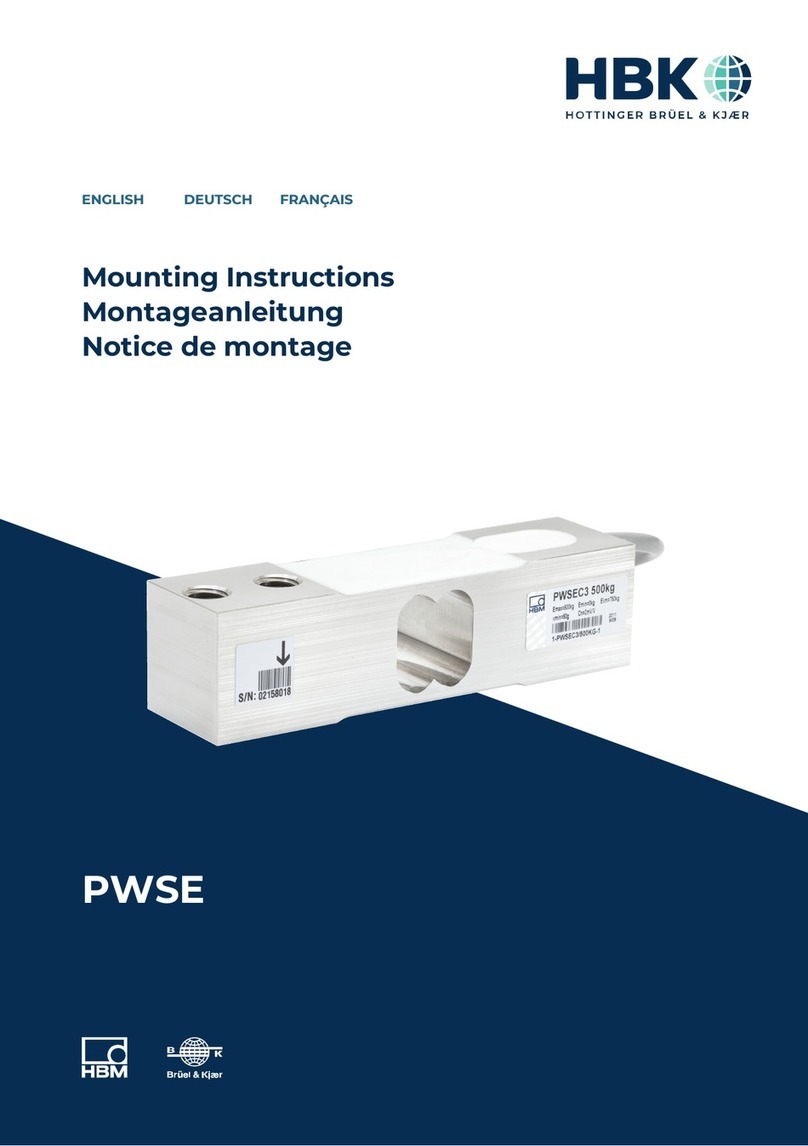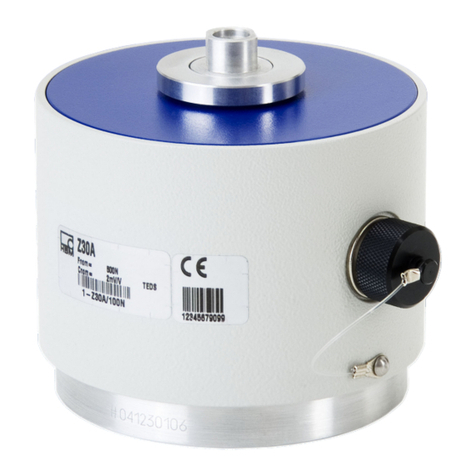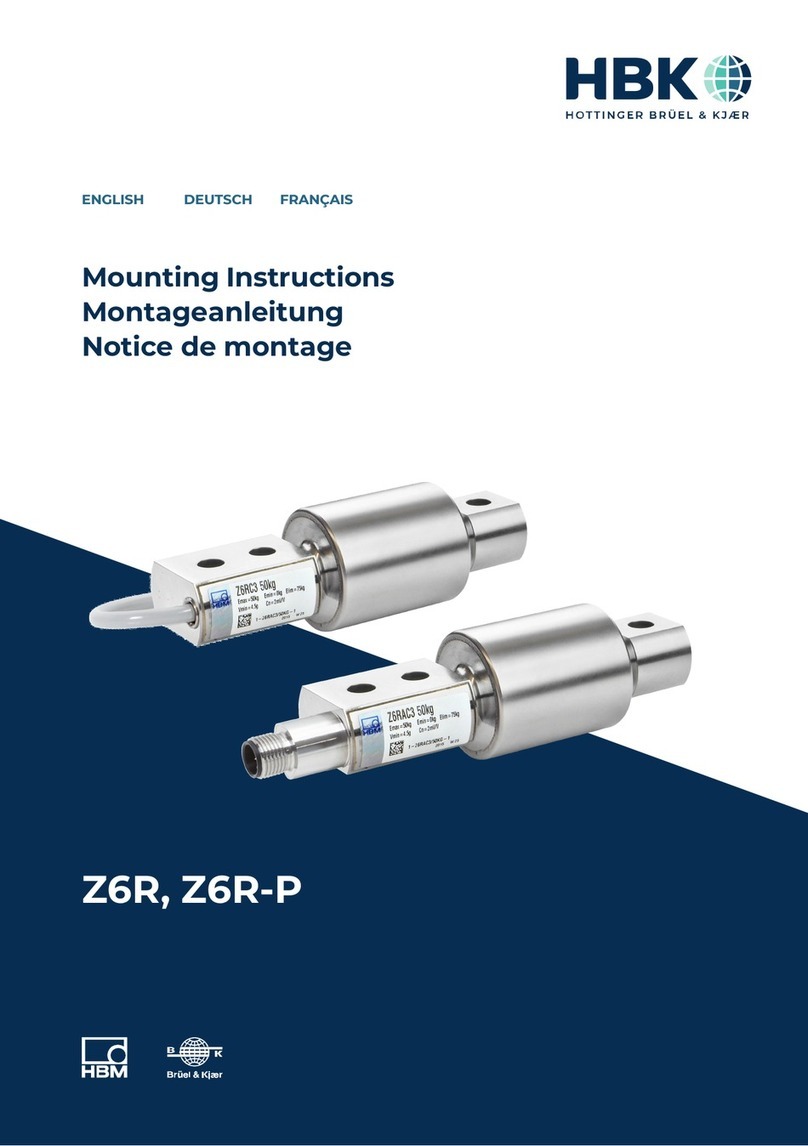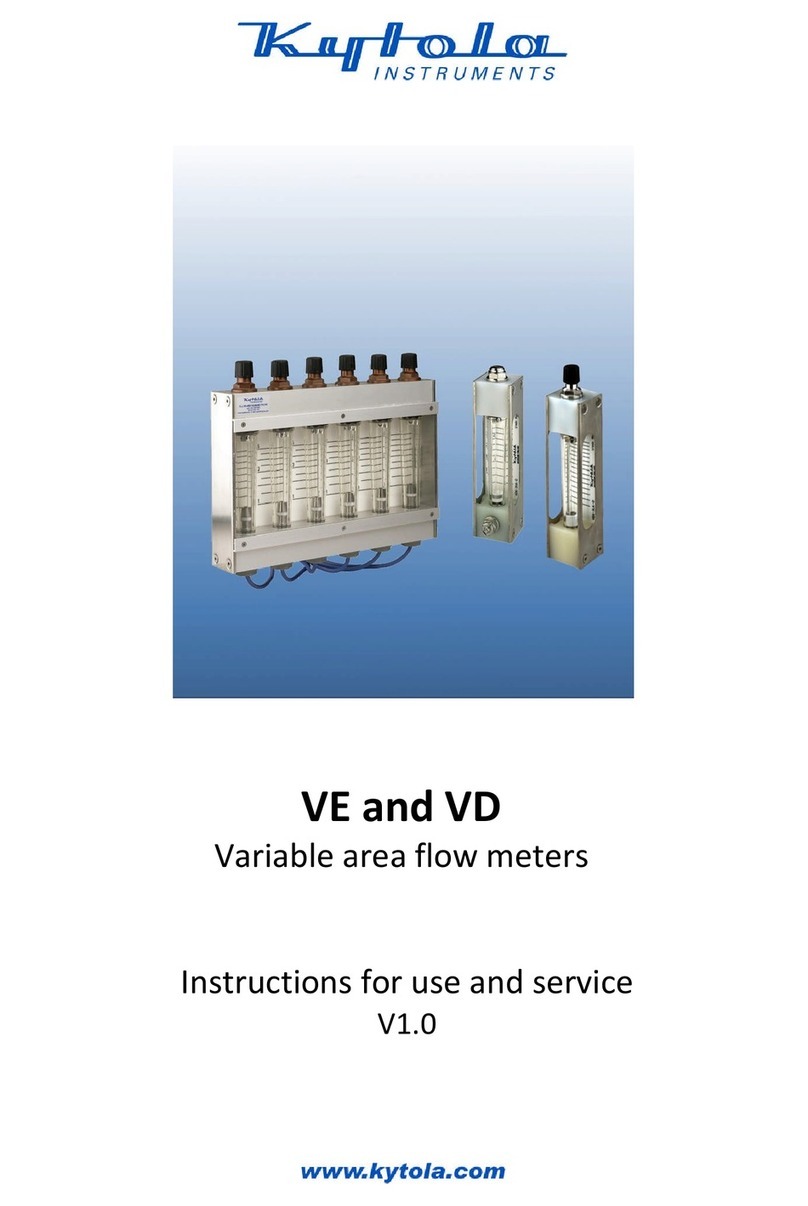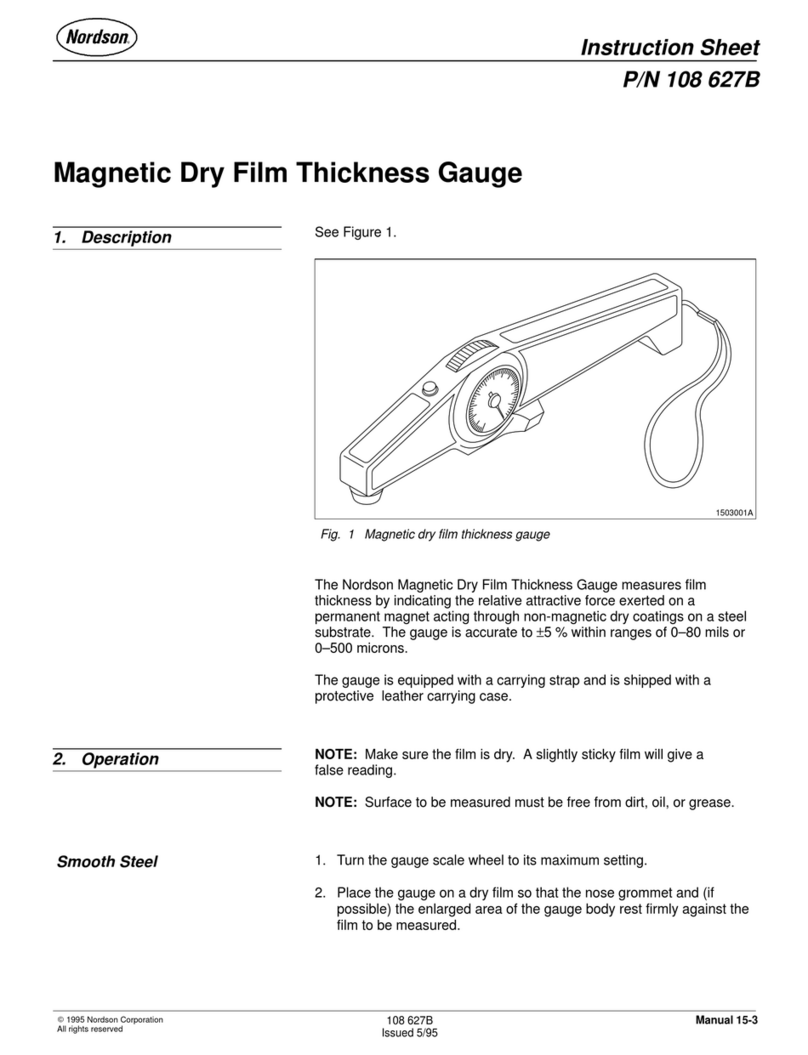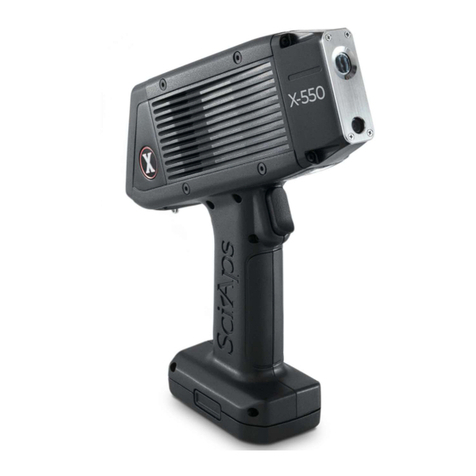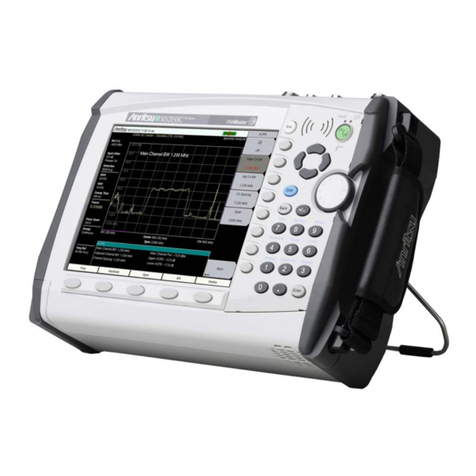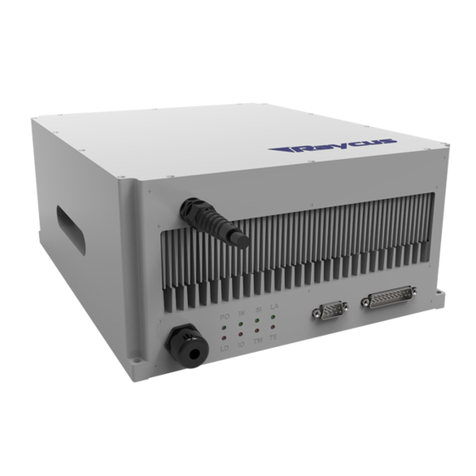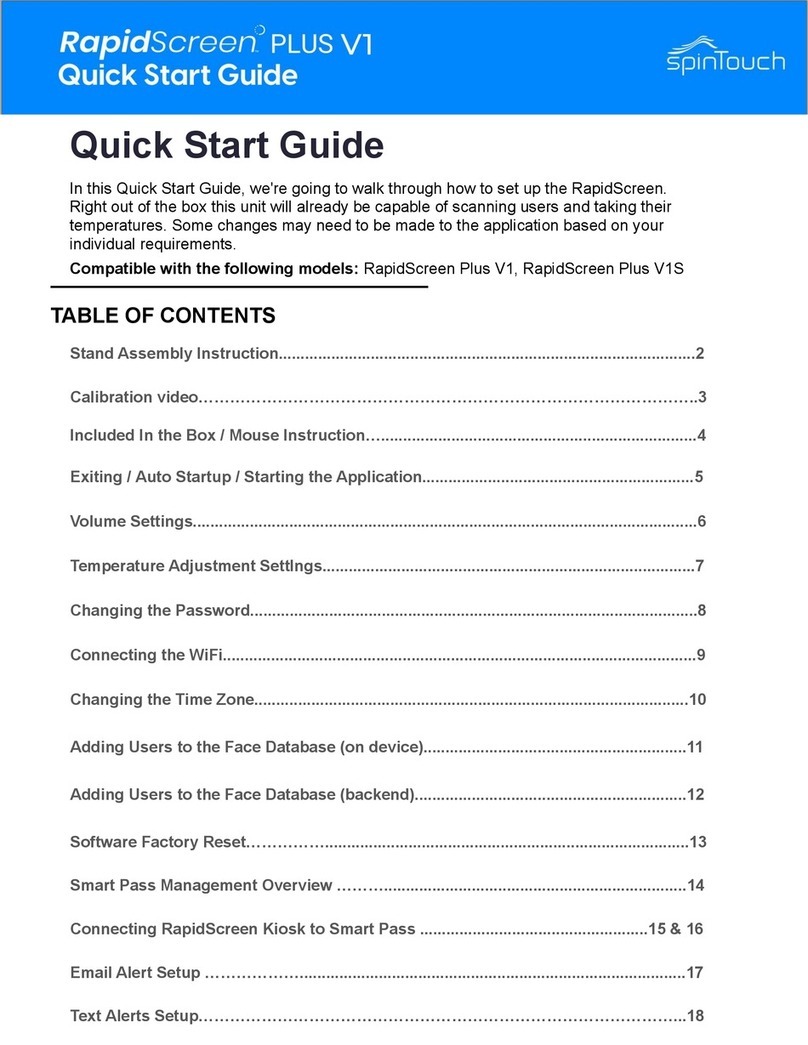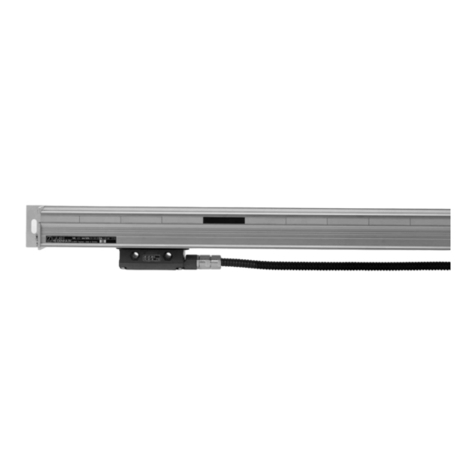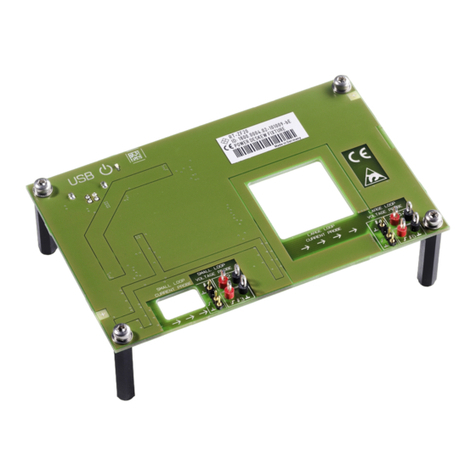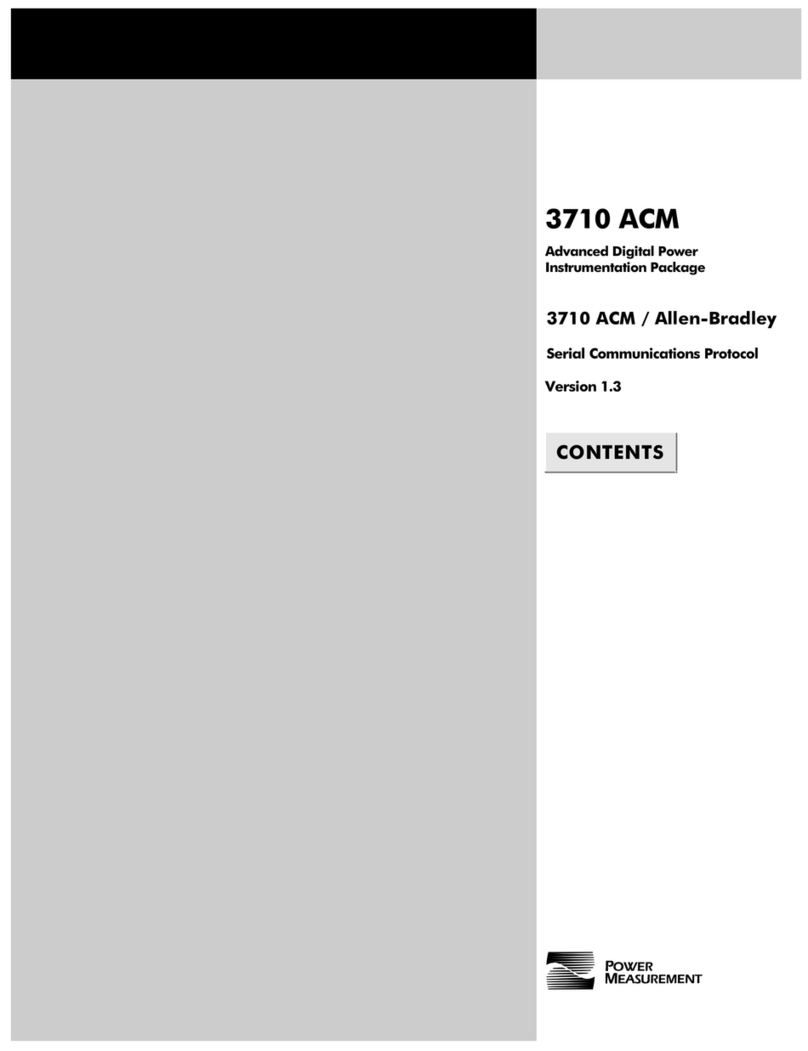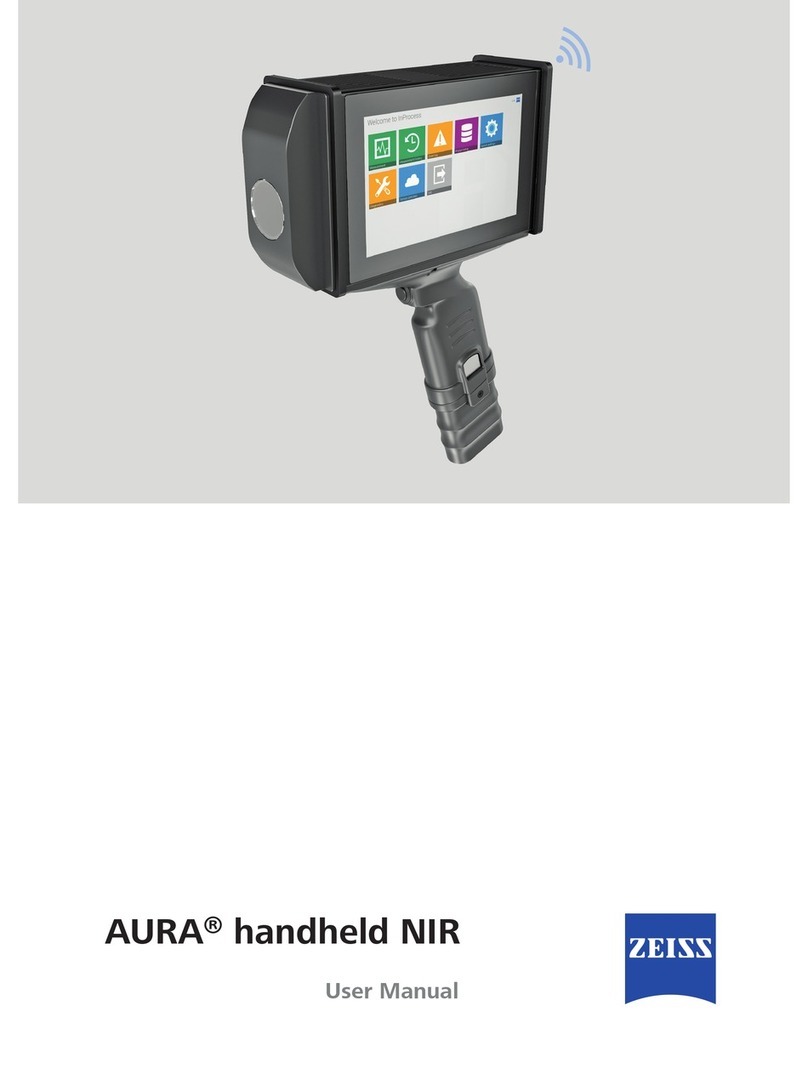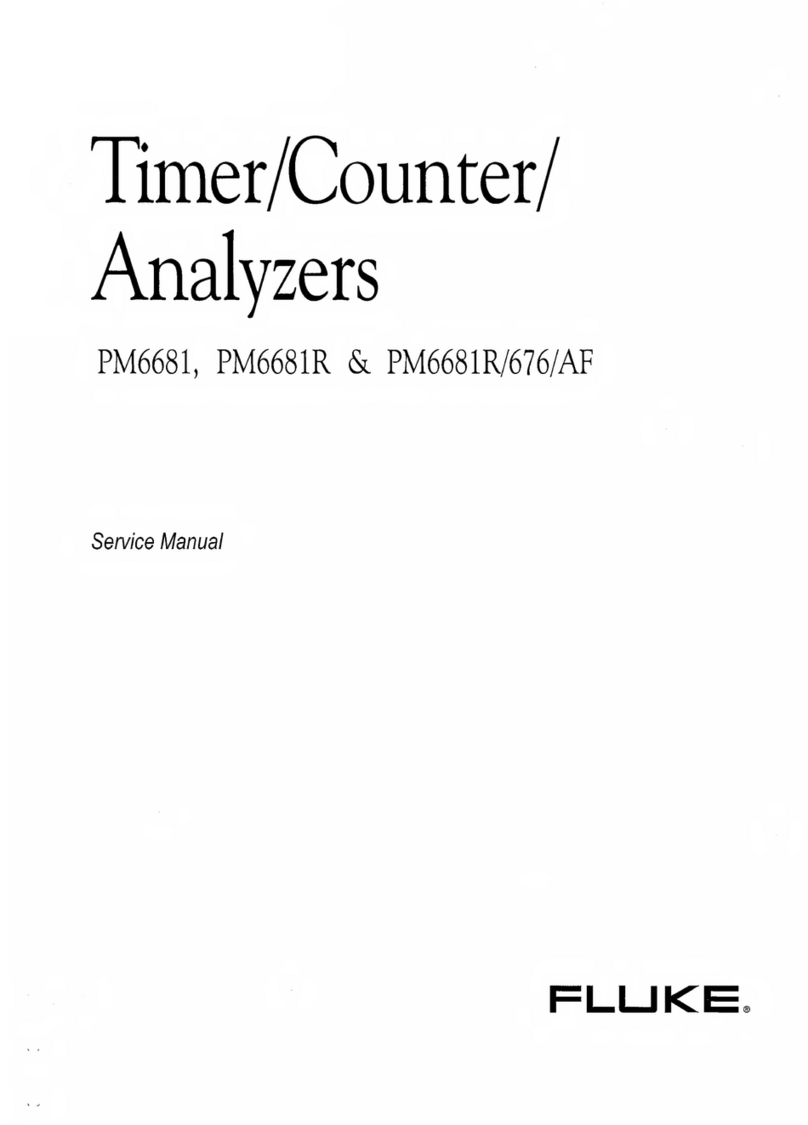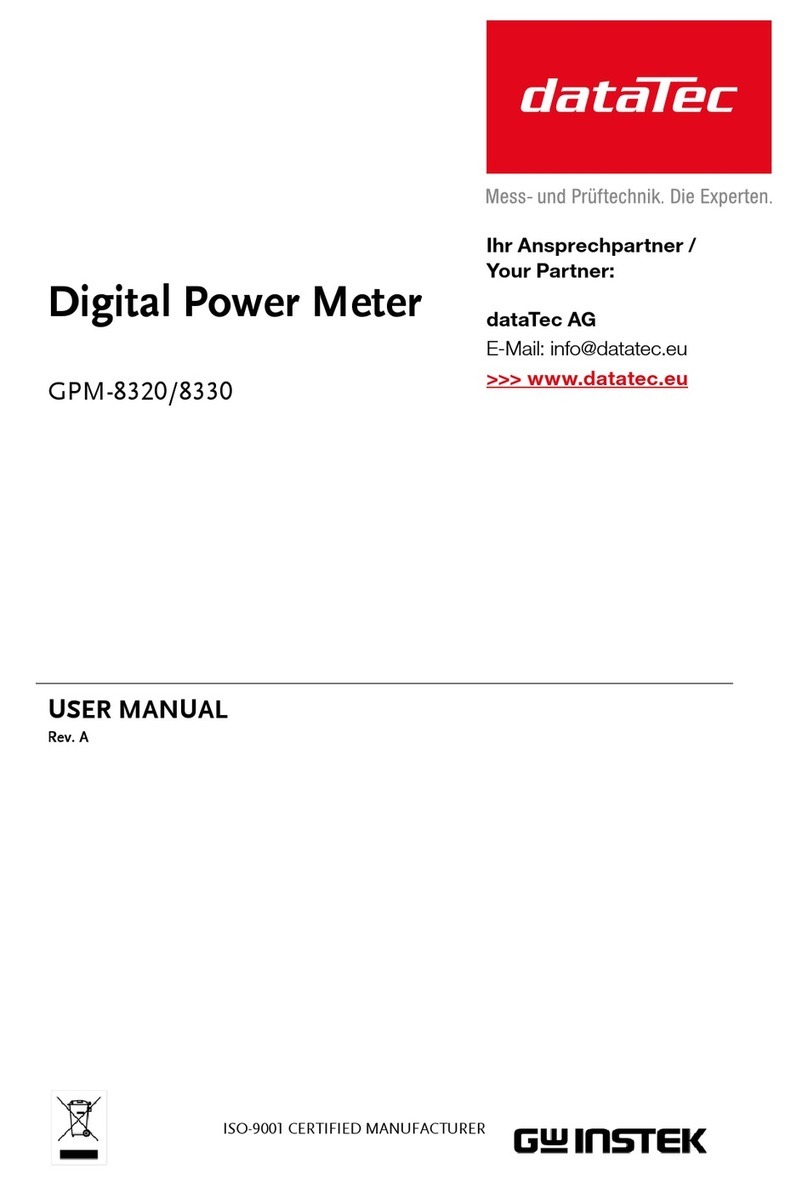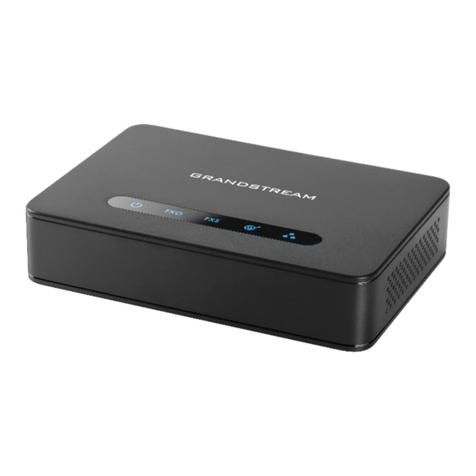HBK PW15AH User manual

PW15AH
ENGLISH DEUTSCH FRANÇAIS
Mounting Instructions
Montageanleitung
Notice de montage

Hottinger Brüel & Kjaer GmbH
Im Tiefen See 45
D-64293 Darmstadt
Tel. +49 6151 803-0
Fax +49 6151 803-9100
www.hbkworld.com
Mat.: 7-0101.0095
DVS: A02435 03 Y00 01
06.2023
EHottinger Brüel & Kjaer GmbH
Subject to modifications.
All product descriptions are for general information
only. They are not to be understood as a guarantee of
quality or durability.
Änderungen vorbehalten.
Alle Angaben beschreiben unsere Produkte in allge
meiner Form. Sie stellen keine Beschaffenheits- oder
Haltbarkeitsgarantie dar.
Sous réserve de modifications.
Les caractéristiques indiquées ne décrivent nos
produits que sous une forme générale. Elles
n'impliquent aucune garantie de qualité ou de
durabilité.

PW15AH
ENGLISH DEUTSCH FRANÇAIS
Mounting Instructions

PW15AH
TABLE OF CONTENTS
2
TABLE OF CONTENTS
1 Safety instructions 3................................................
2 Markings used 6....................................................
2.1 Markings used in this document 6.....................................
2.2 Symbols on the device 6.............................................
3 Application 7.......................................................
4 Mounting and load application 8......................................
4.1 Mounting instructions 8..............................................
4.2 Load application 8..................................................
5 Electrical connection 10..............................................
5.1 Connection in four-wire and six-wire configurations 10.....................
5.2 Cable protection (provided by customer) 11..............................
5.3 Shortening and extending the cable 11..................................
5.4 Parallel connection (option) 11.........................................
5.5 EMC protection 11...................................................
6 Corrosion protection and maintenance 13...............................
7 Specifications 13....................................................
8 Dimensions 14......................................................

3
PW15AH
SAFETY INSTRUCTIONS
1 SAFETY INSTRUCTIONS
Intended use
Load cells of the PW15AH…type series are designed for technical weighing applications
within the load limits detailed in the specifications. Any other use is not the intended use.
The load cells may only be installed by qualified personnel in compliance with the specifi
cations and with the safety requirements and regulations of these mounting instructions.
It is also essential to observe the applicable legal and safety regulations for the applica
tion concerned. The same applies to the use of accessories.
Load cells are not intended for use as safety components. Please also refer to the “Addi
tional safety precautions” section. Proper and safe operation of the load cells requires
proper transportation, correct storage, siting and mounting, and careful operation.
Load-carrying capacity limits
Comply with the data in the technical data sheets when using the load cells. The respec
tive specified maximum loads in particular must never be exceeded. Do not exceed the
values stated in the technical data sheets, for example, for
Slimit load
Slateral load limiting
Sbreaking loads
Stemperature limits
Slimits of electrical load-carrying capacity
Note that when several load cells are installed in a scale, there is not always an even load
distribution on the individual load cells.
Use as machine elements
The load cells can be used as machine elements. When used in this manner, it must be
noted that, to favor greater sensitivity, the load cell is not designed with the safety factors
usual in mechanical engineering. Please refer to the "Load-carrying capacity limits" sec
tion and to the specifications.
Accident prevention
The applicable accident prevention regulations from employers’ liability insurance associ
ations must be taken into account, even though the stated load in the destructive range is
well in excess of the full scale value.

PW15AH
SAFETY INSTRUCTIONS
4
Additional safety precautions
Load cells cannot (as passive transducers) implement any (safety-relevant) cutoffs. This
requires additional components and constructive measures, for which the installer and
operator of the plant is responsible.
In cases where a breakage or malfunction of the load cells would cause injury to persons
or damage to equipment, the user must take appropriate additional safety measures that
meet at least the requirements of applicable safety and accident prevention regulations
(e.g. automatic emergency shutdown, overload protection, catch straps or chains, or
other fall protection).
The electronic processor that processes the measurement signal should be designed so
that failure of the measurement signal cannot lead to secondary failures.
General dangers of failing to follow the safety instructions
Load cells are state-of-the-art and reliable. Transducers can give rise to residual dangers
if they are mounted, installed, used or operated inappropriately or by untrained personnel.
Everyone involved with siting, starting up, operating or repairing a load cell must have
read and understood the mounting instructions and in particular the technical safety
instructions. Load cells may be damaged or destroyed by improper use or non-compli
ance with the mounting and operating manual, these safety instructions or any other
applicable safety regulations (safety and accident prevention regulations of employers’
liability insurance associations) when handling the load cells. Load cells can break, partic
ularly if overloaded. The breakage of a load cell can also cause damage to property or
injury to persons in the vicinity of the load cell.
If load cells are not used according to their designated use, or if the safety instructions or
specifications in the mounting and operating manual are ignored, it is also possible that
the load cells may fail or malfunction, with the result that persons or property may be
affected (due to the loads acting on or being monitored by the load cells).
The scope of supply and performance of the transducer covers only a small area of
weighing technology, as measurements with (resistive) strain gage sensors presuppose
the use of electronic signal conditioning. In addition, equipment planners, installers and
operators should plan, implement and respond to the safety engineering considerations
of the weighing technology in such a way as to minimize residual dangers. Pertinent
national and local regulations must be complied with.
Conversions and modifications
The design or safety engineering of the transducer must not be modified without our
express permission. Any modification shall exclude all liability on our part for any dam
age resulting therefrom.
Resale
If the load cell is resold, these mounting instructions must be included with the load cell.

5
PW15AH
SAFETY INSTRUCTIONS
Environmental protection, disposal
In accordance with national and local environmental protection, material recovery and
recycling regulations, old transducers that are no longer serviceable must be disposed of
separately from normal household waste.
If you require more information about disposal, please contact your local authorities or
the dealer from whom you purchased the product.
Qualified personnel
Qualified personnel means persons entrusted with installing, mounting, starting up and
operating the product, who possess the appropriate qualifications for their function.
This includes people who meet at least one of the three following criteria:
1. Knowledge of the safety concepts of automation technology is a requirement and as
project personnel, you must be familiar with these concepts.
2. As automation plant operating personnel, you have been instructed how to handle the
machinery. You are familiar with the operation of the equipment and technologies
described in this documentation.
3. As commissioning engineers or service engineers, you have successfully completed
the training to repair the automation systems. You are also authorized to operate,
ground and mark circuits and equipment in accordance with safety engineering stan
dards.

PW15AH
MARKINGS USED
6
2 MARKINGS USED
2.1 Markings used in this document
Important instructions for your safety are highlighted. Following these instructions is
essential in order to prevent accidents and damage to property.
Symbol Significance
Notice This marking draws your attention to a situation in
which failure to comply with safety requirements can
lead to damage to property.
Important
This marking draws your attention to important in
formation about the product or about handling the
product.
Tip
This marking indicates application tips or other
information that is useful to you.
Information
This marking draws your attention to information
about the product or about handling the product.
Emphasis
See …
Italics are used to emphasize and highlight text and
identify references to sections, diagrams, or external
documents and files.
2.2 Symbols on the device
CE mark
With the CE mark, the manufacturer guarantees that the product
complies with the requirements of the relevant EC directives (the
Declaration of Conformity can be found on the HBM website
HBM (www.hbm.com) under HBMdoc).
Statutory waste disposal marking
In accordance with national and local environmental protection
and material recovery and recycling regulations, old devices that
can no longer be used must be disposed of separately and not
with normal household garbage.
If you need more information about disposal, please contact
your local authorities or the dealer from whom you purchased
the product.

7
PW15AH
APPLICATION
3 APPLICATION
PW15AH... single-point load cells are available in four maximum capacity ranges from 10
kg to 100 kg. They are suitable for use in the food, packaging and chemicals industries,
and also in retail and agriculture. They are ideal for use in conveyor, floor, shop and
counter scales, as well as in filling and production plants. The PW15AH... load cell is her
metically encapsulated and has the maximum IP rating IP68/IP69K. Furthermore, it fea
tures a connection for cable protection systems, which can permanently protect the con
nection and cable from environmental influences such as dirt, wet, dust and rodents. The
load cell is exceptionally rugged and delivers stable results even in extreme ambient con
ditions.

PW15AH
MOUNTING AND LOAD APPLICATION
8
4 MOUNTING AND LOAD APPLICATION
4.1 Mounting instructions
When mounting the load cells, pay attention to the following:
SPlease handle load cells with care!
SLoad cells are precision sensors and so their achievable accuracy depends greatly on
their being mounted correctly!
SUse suitable hoisting gear for mounting the weighing device!
SDo not overload load cells even briefly (e.g. due to unevenly distributed support
loads)!
SWhen carrying out adjustment work that could endanger the load cells, use supports
(dummies) of equal height!
SAvoid lateral forces and torques!
SDepending on the construction, use anti-liftoff devices and limit stops if necessary!
SProtect load cells against
-one-sided heat radiation
-the influences of subsequent welding work
-strong temperature variations!
Notice
Load cells are precision measuring elements and need to be handled carefully. Dropping or
knocking the transducer may cause permanent damage. Make sure that the transducer
cannot be overloaded, including while it is being mounted.
4.2 Load application
Clamp the load cells firmly at the mounting holes and apply the load at the other end. The
recommended screws and tightening torques can be found in the table below:
Maximum capacities Thread Min. property class Tightening torque1)
10...100 kg M6 10.9 14 N⋅m
1) Recommendedvalue for the specified property class. Please note the information on screw dimensions
provided by the screw manufacturer.
Load must not be applied to the side where the cable connection is located, as this would
cause a force shunt.

9
PW15AH
MOUNTING AND LOAD APPLICATION
Platformcenter
Load application
Connection cable
Mounting
Spacing washer

PW15AH
ELECTRICAL CONNECTION
10
5 ELECTRICAL CONNECTION
The following can be connected for measurement signal conditioning:
SCarrier-frequency amplifiers
SDC voltage amplifiers
that are designed for strain gage measurement systems.
5.1 Connection in four-wire and six-wire configurations
When load cells with a six-wire configuration are connected to amplifiers with a four-wire
configuration, the sense leads of the load cells must be connected to the corresponding
supply leads: Marking (+) with (+) and marking (-) with (-).
6-wire cable connection (available lengths: 3 m; 6 m)
4
Plug-in contact1 (white) = measurement signal(+)
Plug-in contact3 (black) = excitation voltage(-)
Plug-in contact 6 (gray) = sense line (-)
Plug-in contact4 (blue) = excitation voltage(+)
Plug-in contact5 (green) = sense line(+)
Plug-in contact2 (red) = measurement signal(-)
Shield (yellow) = cable shield connected to load
cell body
Schematic diagram of a Pancon connector (CE100F26-6), 6-pin
1
23
56
Blue marking

11
PW15AH
ELECTRICAL CONNECTION
5.2 Cable protection (provided by customer)
Cable protection system*, comprising:
Unscrew the M12 sleeve and replace
with an M12 threaded tube coupling
* Supplier, e.g. Flexicon,
e-mail: info@icp‐solutions.de
Screwed cable gland*
Cable protection tubing*
O-ring (provided by customer)
Even without a cable protection system, standard load cells can achieve an IP rating of
IP68/IP69K. In applications where the PVC cable of the load cell could be chemically or
mechanically attacked or destroyed, extra cable protection can be provided using stan
dard cable protection systems.
5.3 Shortening and extending the cable
When a six-wire configuration is used, the 6‐wire cable of the load cell can be shortened
with no adverse effect on measurement accuracy.
Use only shielded, low-capacitance measurement cables to extend cables, making sure
there is a proper connection with minimal contact resistance.
The cable of a six-wire load cell can be extended using a cable of the same type.
5.4 Parallel connection (option)
Only single-point load cells with a compensated output (nominal (rated) sensitivity and
output resistance) are suitable for parallel connection.
5.5 EMC protection
Electrical and magnetic fields often induce interference voltages in the measuring circuit.
To ensure reliable measurement, however, the transducer must be able to transmit signal
differences of a few μV to the analysis unit without interference.
Planning the shielding design
Due to the numerous application options and differing local constraints, we can only
provide you with general information on correct connection. The shielding design suitable
for your application must be planned locally by an appropriate specialist.

PW15AH
ELECTRICAL CONNECTION
12
HBM load cells with shielded, round cables are EMC-tested in accordance with the
EU Directive and bear the CE mark. Voltage surges as per EN 61000-4-5 can give rise to
deviations from the load cell’s specified accuracy. These surges in plants are caused by
lightning strikes or switching operations in power circuits, for example, and disappear
again when interference is no longer active. This is particularly evident with cables over
30 m long or if the equipment is used outdoors. Customers should take additional pre
cautions in these cases.
Please note:
SConnect the connecting cable shield all over the surface of the shielding electronics
housing. When using several load cells, connect the shields all over the surface of the
junction box (combination of transducer signals, e.g. type VKK2 from HBM). From
there, connect the measurement cable for the electronics over the surface of the
junction box and the shielding electronics housing.
SThe shield of the connecting cable must not be used for discharging potential
differences within the system. You must therefore lay sufficiently dimensioned
potential equalization lines to compensate for possible potential differences.
SUse shielded low-capacitance measurement cables only (HBM cables fulfill these
conditions).
SDo not route measurement cables parallel to electric cables, especially power lines
and control circuits. If this is not possible, protect the measurement cable, for
example with steel conduits.
SAvoid stray fields from transformers, motors and contact switches.

13
PW15AH
CORROSION PROTECTION AND MAINTENANCE
6 CORROSION PROTECTION AND MAINTENANCE
Protect load cells against chemicals that could attack the cable or the steel of the hous
ing.
Notice
Acids and all substances that release ions also attack stainless steels and their weld
seams.
The resulting corrosion could cause the transducer to fail. If this is the case, you must pro
vide appropriate means of protection.
The transducer is basically maintenance free.
Dust, dirt and other foreign matter must not be allowed to accumulate sufficiently to
divert some of the measuring force onto the housing, thus distorting the measured value
(force shunt).
Do not use hard or pointed objects to clean the transducer. The transducer achieves an IP
rating of IP68 (test conditions: 100 hours under 1 m water column) and IP69K (water at
high pressure, steam cleaning), as per DIN EN 60529. The transducer is therefore suitable
for wet cleaning. Despite this, the transducer should be protected against the long-term
effects of moisture.
7 SPECIFICATIONS
Information
For more product information, visit www.hbm.com/de/pw.

PW15AH
DIMENSIONS
14
8 DIMENSIONS
Type plate
S/N label
Cable length
3000+50
0
12
Cn=2mV/V
Elim=15kg
Emin=0kg
PW15AHC3 10kg
vmin=1g
Emax=10kg
1-PW15AHC3/10KG-1
40±0.15
19±0.1
55±5
12
12
7-M6
25±0.3
19±0.1 19±0.1
6
100±0.2
150±0.2
M6X0.5
TC11279
Connection cable
Connector
Dimensions (in mm; 1mm=0.03937inches)

PW15AH
ENGLISH DEUTSCH FRANÇAIS
Montageanleitung

PW15AH
INHALTSVERZEICHNIS
2
INHALTSVERZEICHNIS
1 Sicherheitshinweise 3...............................................
2 Verwendete Kennzeichnungen 6......................................
2.1 In dieser Anleitung verwendete Kennzeichnungen 6......................
2.2 Auf dem Gerät angebrachte Symbole 6.................................
3 Anwendung 7......................................................
4 Montage und Lasteinleitung 8........................................
4.1 Montagehinweise 8.................................................
4.2 Lasteinleitung 8....................................................
5 Elektrischer Anschluss 10............................................
5.1 Anschluss in Vier‐ und Sechsleiter‐Technik 10............................
5.2 Kabelschutz (kundenseitig vorzusehen) 11...............................
5.3 Kabelkürzung und Kabelverlängerung 11................................
5.4 Parallelschaltung (Option) 11..........................................
5.5 EMV-Schutz 11......................................................
6 Korrosionsschutz und Wartung 13.....................................
7 Technische Daten 14.................................................
8 Abmessungen 15....................................................

3
PW15AH
SICHERHEITSHINWEISE
1 SICHERHEITSHINWEISE
Bestimmungsgemäße Verwendung
Die Wägezellen der Typenreihe PW15AH…sind für wägetechnische Anwendungen im
Rahmen der durch die technischen Daten spezifizierten Belastungsgrenzen konzipiert.
Jeder andere Gebrauch ist nicht bestimmungsgemäß.
Die Wägezellen dürfen nur von qualifiziertem Personal ausschließlich entsprechend der
technischen Daten unter Beachtung der Sicherheitsbestimmungen und Vorschriften
dieser Montageanleitung eingesetzt werden. Zusätzlich sind die für den jeweiligen
Anwendungsfall geltenden Rechts‐ und Sicherheitsvorschriften zu beachten. Sinngemäß
gilt dies auch bei Verwendung von Zubehör.
Die Wägezellen sind nicht zum Einsatz als Sicherheitsbauteile bestimmt. Bitte beachten
Sie hierzu den Abschnitt „Zusätzliche Sicherheitsvorkehrungen“. Der einwandfreie und
sichere Betrieb der Wägezellen setzt sachgemäßen Transport, fachgerechte Lagerung,
Aufstellung und Montage sowie sorgfältige Bedienung voraus.
Belastbarkeitsgrenzen
Beim Einsatz der Wägezellen sind die Angaben in den technischen Datenblättern unbe
dingt zu beachten. Insbesondere dürfen die jeweils angegebenen Maximalbelastungen
keinesfalls überschritten werden. Nicht überschritten werden dürfen z.B. die in den
technischen Datenblättern angegebenen Werte für
SGrenzlast
SGrenzquerbelastung
SBruchlasten
STemperaturgrenzen
SGrenzen der elektrischen Belastbarkeit
Beachten Sie, dass beim Einbau mehrerer Wägezellen in eine Waage die Lastverteilung
auf die einzelnen Wägezellen nicht immer gleichmäßig ist.
Einsatz als Maschinenelemente
Die Wägezellen können als Maschinenelemente eingesetzt werden. Bei dieser
Verwendung ist zu beachten, dass die Wägezellen zu Gunsten einer hohen Messempfind
lichkeit nicht mit den im Maschinenbau üblichen Sicherheitsfaktoren konstruiert wurden.
Beachten Sie hierzu den Abschnitt „Belastbarkeitsgrenzen“ und die technischen Daten.
Unfallverhütung
Obwohl die angegebene Last im Zerstörungsbereich ein Mehrfaches vom Messbereichs
endwert beträgt, müssen die einschlägigen Unfallverhütungsvorschriften der Berufsge
nossenschaften berücksichtigt werden.

PW15AH
SICHERHEITSHINWEISE
4
Zusätzliche Sicherheitsvorkehrungen
Die Wägezellen können (als passive Aufnehmer) keine (sicherheitsrelevanten)
Abschaltungen vornehmen. Dafür bedarf es weiterer Komponenten und konstruktiver
Vorkehrungen, für die der Errichter und Betreiber der Anlage Sorge zu tragen hat.
Wo bei Bruch oder Fehlfunktion der Wägezellen Menschen oder Sachen zu Schaden
kommen können, müssen vom Anwender geeignete zusätzliche Sicherheitsvorkehrungen
getroffen werden, die zumindest den Anforderungen der einschlägigen Unfallverhütungs
vorschriften genügen (z.B. automatische Notabschaltungen, Überlastsicherungen,
Fanglaschen oder ‐ketten oder andere Absturzsicherungen).
Die das Messsignal verarbeitende Elektronik ist so zu gestalten, dass bei Ausfall des
Messsignals keine Folgeschäden auftreten können.
Allgemeine Gefahren bei Nichtbeachten der Sicherheitshinweise
Die Wägezellen entsprechen dem Stand der Technik und sind betriebssicher. Von den
Aufnehmern können Gefahren ausgehen, wenn sie von ungeschultem Personal oder
unsachgemäß montiert, aufgestellt, eingesetzt und bedient werden. Jede Person, die mit
Aufstellung, Inbetriebnahme, Betrieb oder Reparatur einer Wägezelle beauftragt ist, muss
die Montageanleitung und insbesondere die sicherheitstechnischen Hinweise gelesen
und verstanden haben. Bei nicht bestimmungsgemäßem Gebrauch der Wägezellen, bei
Nichtbeachtung der Montage‐ und Bedienungsanleitung, dieser Sicherheitshinweise oder
sonstiger einschlägiger Sicherheitsvorschriften (Unfallverhütungsvorschriften der BG)
beim Umgang mit den Wägezellen, können die Wägezellen beschädigt oder zerstört
werden. Insbesondere bei Überlastungen kann es zum Bruch von Wägezellen kommen.
Durch den Bruch einer Wägezelle können darüber hinaus Sachen oder Personen in der
Umgebung der Wägezelle zu Schaden kommen.
Werden Wägezellen nicht ihrer Bestimmung gemäß eingesetzt oder werden die
Sicherheitshinweise oder die Vorgaben der Montage‐ oder Bedienungsanleitung außer
Acht gelassen, kann es ferner zum Ausfall oder zu Fehlfunktionen der Wägezellen kom
men, mit der Folge, dass (durch auf die Wägezellen einwirkende oder durch diese
überwachte Lasten) Menschen oder Sachen zu Schaden kommen können.
Der Leistungs‐ und Lieferumfang des Aufnehmers deckt nur einen Teilbereich der Wäge
technik ab, da Messungen mit (resistiven) DMS‐Sensoren eine elektronische Signalver
arbeitung voraussetzen. Sicherheitstechnische Belange der Wägetechnik sind zusätzlich
vom Anlagenplaner/Ausrüster/Betreiber so zu planen, zu realisieren und zu verantworten,
dass Restgefahren minimiert werden. Die jeweils existierenden nationalen und örtlichen
Vorschriften sind zu beachten.
Umbauten und Veränderungen
Der Aufnehmer darf ohne unsere ausdrückliche Zustimmung weder konstruktiv noch
sicherheitstechnisch verändert werden. Jede Veränderung schließt eine Haftung unserer
seits für daraus resultierende Schäden aus.
Table of contents
Languages:
Other HBK Measuring Instrument manuals
